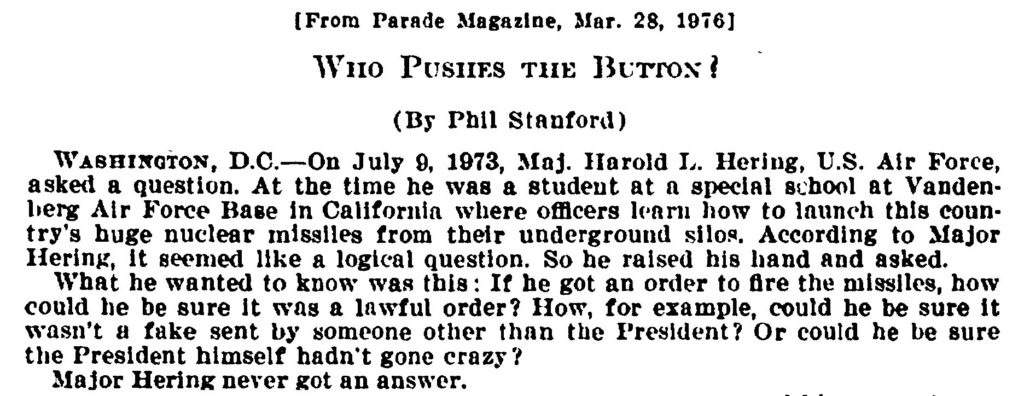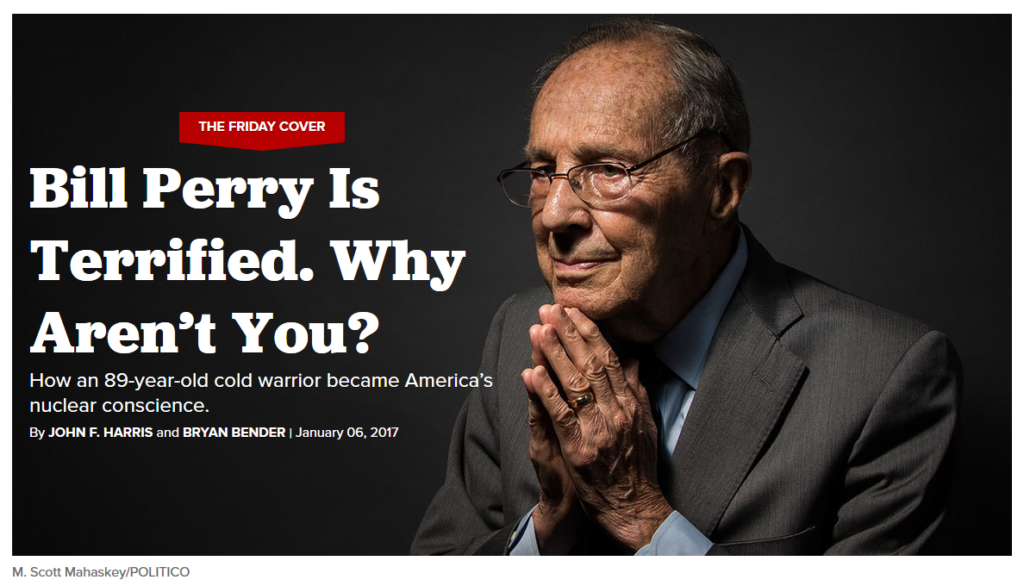(Excerpt) The President may direct the use of nuclear weapons through an execute order via the Chairman of the Joint Chiefs of Staff to the combatant commanders and, ultimately, to the forces in the field exercising direct control of the weapons.
(The Nuclear Secrecy Blog of Alex Wellerstein) asked William J. Perry, the former Secretary of Defense, at point blank whether the Secretary of Defense was in the chain of command. The answer was a clear “no.” Perry explained that while, presumably the Secretary of Defense would express opinions and given counsel, the President was under no legal obligation to take such counsel, and the objection of the Secretary of Defense had no bearing either legally or practically.
- (W)hen doctrine says “the Chairman of the Joint Chiefs of Staff,” it is usually referring to a staff and not an individual person. Which is to say, it doesn’t necessarily indicate an individual personage, but instead indicates a web of people that are connected to the authority of that personage.
- The employment of nuclear weapons at any level requires explicit orders from the President. The nature of nuclear weapons — overwhelmingly more significant than conventional weapons — is such that their use can produce political and psychological effects well beyond their actual physical effects. The employment of nuclear weapons may lead to such unintended consequences as escalation of the current conflict or long-term deterioration of relations with other countries. For this reason above all others, the decision whether or not to use nuclear weapons will always be a political decision and not a military one.
The President and the Bomb, Part III
by Alex Wellerstein
Part 3, published April 10th, 2017
- How many people are in between the President and the actual use of nuclear weapons? Where exactly is the “jump” between the “political” wing of the US government (e.g., the Executive Branch) and the “military” wing that actually implements the order?
No one can stop President Trump from using nuclear weapons. That’s by design.
The whole system is set up so the president — and only the president — can decide when to launch.
Via the Washington Post
By Alex Wellerstein December 1, 2016
Alex Wellerstein is a historian of nuclear weapons at the Stevens Institute of Technology.
He runs the website Restricted Data: The Nuclear Secrecy Blog.
- (Bruce) Blair has insisted (in e-mail to me, and in our interview) that the whole “could the Secretary of Defense refuse an order” question was a red herring. The Secretary of Defense, he insisted, was completely dispensable with regards to the deployment of nuclear weapons. As I noted in my Post piece, there are several descriptions of the nuclear chain of command that imply that the Secretary of Defense is necessary, as the “conduit” (my term) between the political and military worlds. But is it true? Blair emphatically said no…
DOD Directive 5100.30 states:
The NCA [National Command Authorities] consists only of the President and the Secretary of Defense or their duly deputized alternates or successors. The chain of command runs from the President to the Secretary of Defense and through the Joint Chiefs of Staff to the Commanders of the Unified and Specified Commands. The channel of communication for execution of the Single Integrated Operational Plan (SIOP) and other time-sensitive operations shall be from the NCA through the Chairman of the Joint Chiefs of Staff, representing the Joint Chiefs of Staff, to the executing commanders.
- Which seems to set up the Secretary of Defense as an essential part of the chain. The directive in question is not especially recent (the unclassified version of the directive dates from 1974), and it doesn’t clarify exactly how important the Secretary of Defense might be.
- But over the last few weeks… and my own further digging into the matter, I have become convinced that the weight of the open evidence points to the idea that Blair is correct — the Secretary of Defense is not just unnecessary, but not even in the nuclear chain of command.
- On the website of the USAF’s (appropriately named) Curtis E. LeMay Center for Doctrine Development and Education, one can find ANNEX 3-72 NUCLEAR OPERATIONS, last updated in May 2015.
The President may direct the use of nuclear weapons through an execute order via the Chairman of the Joint Chiefs of Staff to the combatant commanders and, ultimately, to the forces in the field exercising direct control of the weapons.
- Which seems pretty definitive. The order jumps immediately from the President to the military, in the form of the Chairman of the Joint Chiefs of Staff, and from there percolates through the system of command, control, and communication to the various people who actually turn the keys and put the “birds” into the air.
- (T)he nuclear command and control system is set up, both practically and doctrinally, to avoid asking the questions that are seen as being in the purview of the “political” side of the equation. From the same “Annex 3-72” (Alex Wellerstein’s emphasis in the par. below):
The employment of nuclear weapons at any level requires explicit orders from the President. The nature of nuclear weapons — overwhelmingly more significant than conventional weapons — is such that their use can produce political and psychological effects well beyond their actual physical effects. The employment of nuclear weapons may lead to such unintended consequences as escalation of the current conflict or long-term deterioration of relations with other countries. For this reason above all others, the decision whether or not to use nuclear weapons will always be a political decision and not a military one.
- Now, obviously conditions would dictate varying responses. I have faith that an “obviously bonkers” order would be somehow avoided (e.g., a frothing, “nuke them all, ha ha ha,” sort of thing). I’m not worried about that situation (it’s not outside the realm of human possibility — all humans are fallible, many develop various forms of mental illness, etc.), but I am worried about what I consider to be “ill-advised” orders, or “bad idea” orders, or “spur of the moment” orders that are considerably less apocalyptic (at least on their surface) than, say, a full nuclear exchange.
- (T)he notion that the system won’t work as intended is not a real “check.” It’s just hoping things will break in a way that would be convenient. I think we can do better, and I think that the consequences associated with the possibility of the rash use of nuclear weapons by an American President — any President — large enough to warrant trying to make a better (if not perfect) system…
- One of the cases I mentioned in my Post piece was Harold Hering, the Major who was kicked out of the Air Force for asking a “dangerous question” while training to be a Missile Launch Officer at Vandenberg Air Force Base. Hering had asked, in essence, how could he, in his Minuteman missile bunker, know that an order to launch he received from the President had been a legal, considered, and sane one?

Comment:
Alex Wellerstein: I don’t want to get into the “insane president” discussion again because I’ve talked about it in part II and it strikes me as a total red herring anyway. One can imagine lots of situations where presidents would be rashly tempted to use nuclear weapons without them being literally insane. Historically, their advisors have certainly been in that situation (Nina Tannenwald’s book on the ‘nuclear taboo’ contains many such examples from many different presidencies). I suspect, but do not know, that there is no formal mechanism in place at STRATCOM for determining whether the president is competent or not — and frankly, I am not sure what such a mechanism would even look like, if it did exist. (Anyone who has actually dealt with the mentally ill or mentally impaired can tell you that they can be remarkably lucid and even self-rationalizing) …
Part 1, the President and the Bomb
Part 2, the President and the Bomb, Redux
Part 3, the President and the Bomb III
◊
(StratDem editor: The Parade Magazine citation above from 1976 recalls its editor, Lloyd Shearer (“Skip”), who was to become the father-in-law of Strobe Talbott, a close friend of President Bill Clinton and writer on diplomatic-nuclear issues for Time, who went on to oversee the U.S. Russian nuclear arms negotiations before his later career as President of Brookings Institute. Strobe’s Strobe Talbott books such as Russia Hand, and Endgame, are historical records given to me from this era of nuclear arms control. Yet, going forward, the risks of nuclear use have multiplied dangerously and we as a nation have moved far from drawdown of nuclear weapons into a new era of nuclear arms escalation. A president who now threatens use of nuclear weapons, and everyday brings an unprecedented chaos into decision-making, is not reassuring. Clearly, as Professor Wellerstein says in conclusion to his President and the Bomb series, it is time to reexamine command and control of nuclear weapons as StratDem and others have proposed over the course of 2016 / 2017.)
◊



